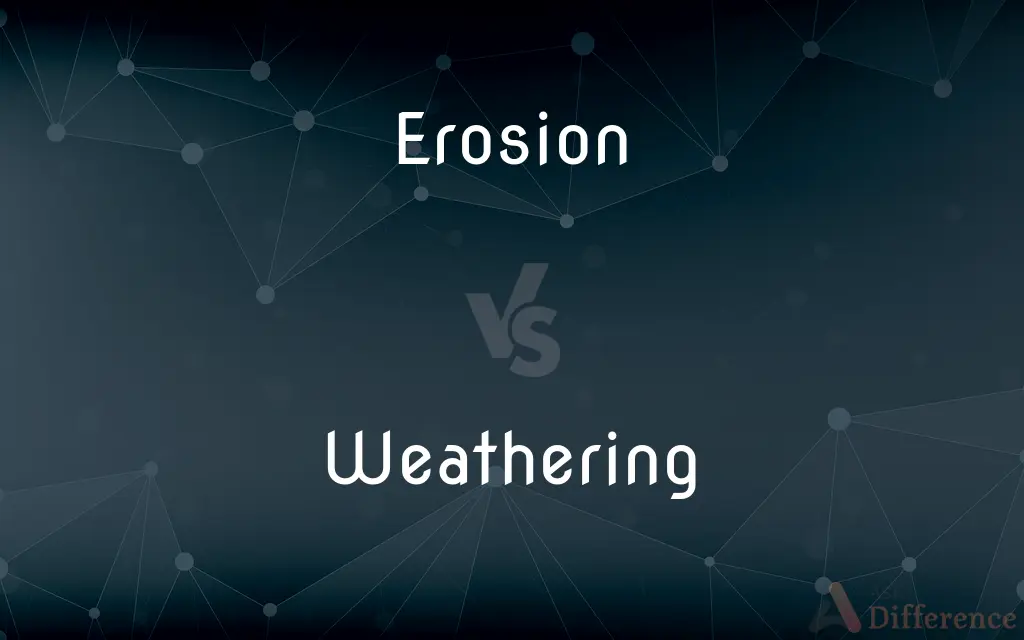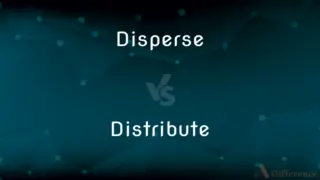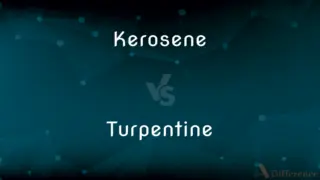Erosion vs. Weathering — What's the Difference?
Edited by Tayyaba Rehman — By Fiza Rafique — Updated on April 21, 2024
Erosion involves the movement of rock or soil by natural forces like water or wind, while weathering is the breakdown of rocks and minerals in place.

Difference Between Erosion and Weathering
Table of Contents
ADVERTISEMENT
Key Differences
Erosion is primarily driven by water, wind, and ice, which physically move soil and rock from one location to another, enhancing landscape changes. Whereas weathering involves the chemical, physical, and biological processes that break down rocks and minerals on the Earth's surface without moving them, contributing mainly to soil formation.
Erosion can create new geographical features such as valleys or deltas through the transport of materials. On the other hand, weathering often results in the alteration of rock surfaces, leading to features like caves or crevices.
The agents of erosion, including running water and glacial ice, are dynamic and can drastically reshape landscapes over relatively short geological periods. In contrast, weathering agents like temperature changes and water often work more slowly and subtly.
While erosion is often dependent on weather conditions, such as heavy rainfall or rapid snowmelt, which can accelerate processes like riverbank erosion or coastal degradation, weathering processes like oxidation and hydration are more consistent, influenced primarily by the presence of certain chemicals in the environment.
Erosion typically results in the deposition of sediment in new locations, which can create fertile grounds for new ecosystems. Conversely, weathering typically leads to the gradual accumulation of organic material on rock surfaces, which can foster distinct ecosystems like lichens or mosses.
ADVERTISEMENT
Comparison Chart
Definition
Movement of soil and rock particles
Breakdown and decomposition of rocks
Main Agents
Water, wind, ice
Water, oxygen, carbon dioxide
Resulting Features
Valleys, deltas, canyons
Caves, crevices, expanded cracks
Speed of Process
Can be rapid or slow
Generally slow, but varies
Dependency on Climate
High (influenced by rainfall, etc.)
Lower (more constant processes)
Compare with Definitions
Erosion
The wearing away of the Earth's surface by wind, water, or ice.
Wind erosion can dramatically reshape desert landscapes.
Weathering
A gradual process of decay and disintegration of rocks or buildings.
The old fort's walls show significant signs of weathering.
Erosion
The process of eroding or being eroded by natural forces.
Glacier erosion has formed many of our planet's valleys.
Weathering
The breaking down or dissolving of rocks and minerals on the Earth’s surface.
Weathering of limestone has created numerous underground caves.
Erosion
A geological process where soil and rock are removed from the Earth's surface by exogenic processes.
Soil erosion reduces agricultural productivity.
Weathering
The effect of exposure to the atmosphere on materials like rocks and metal.
Granite weathers slower than marble under similar conditions.
Erosion
The gradual degradation of biological or geological features by natural agents.
Coastal erosion is accelerated by higher sea levels.
Weathering
Biological weathering involving plants or animals that break down rock.
Tree roots can cause significant weathering of rock substrates.
Erosion
The process by which natural forces move weathered rock and soil from one place to another.
Erosion by river water carved the Grand Canyon.
Weathering
The process by which rocks are broken down by natural forces without moving.
Chemical weathering through acid rain can damage ancient sculptures.
Erosion
In earth science, erosion is the action of surface processes (such as water flow or wind) that removes soil, rock, or dissolved material from one location on the Earth's crust, and then transports it to another location. Erosion is distinct from weathering which involves no movement.
Weathering
Weathering is the breaking down of rocks, soils, and minerals as well as wood and artificial materials through contact with water, atmospheric gases, and biological organisms. Weathering occurs in situ (on site, with little or no movement), and should not be confused with erosion, which involves the transport of rocks and minerals by agents such as water, ice, snow, wind, waves and gravity.
Erosion
The group of natural processes, including weathering, dissolution, abrasion, corrosion, and transportation, by which material is worn away from the earth's surface.
Weathering
Any of the chemical or mechanical processes by which objects exposed to the weather are worn or broken down.
Erosion
The superficial destruction of bodily tissue by friction, pressure, ulceration, or trauma.
Weathering
(obsolete) Weather, especially favourable or fair weather.
Erosion
The process of eroding or the condition of being eroded
Erosion of confidence in the governor.
Erosion of the value of the dollar.
Weathering
(geology) Mechanical or chemical breaking down of rocks in situ by weather or other causes.
Erosion
(uncountable) The result of having been worn away or eroded, as by a glacier on rock or the sea on a cliff face.
Weathering
(architecture) A slight inclination given to an approximately horizontal surface to enable it to throw off water.
Erosion
(uncountable) The changing of a surface by mechanical action, friction, thermal expansion contraction, or impact.
Weathering
The action of weather on objects exposed to it.
Erosion
The gradual loss of something as a result of an ongoing process.
The erosion of a person's trust
Trademark erosion, caused by everyday use of the trademarked term
Weathering
Present participle of weather
Erosion
(uncountable) Destruction by abrasive action of fluids.
Weathering
The action of the elements on a rock in altering its color, texture, or composition, or in rounding off its edges.
Erosion
One of two fundamental operations in morphological image processing from which all other morphological operations are derived.
Erosion
(dentistry) Loss of tooth enamel due to non-bacteriogenic chemical processes.
Erosion
(medicine) A shallow ulceration or lesion, usually involving skin or epithelial tissue.
Erosion
(math) In morphology, a basic operation (denoted ⊖); see Erosion (morphology).
Erosion
The act or operation of eroding or eating away.
Erosion
The state of being eaten away; corrosion; canker.
Erosion
The wearing away of the earth's surface by any natural process. The chief agent of erosion is running water; minor agents are glaciers, the wind, and waves breaking against the coast.
Erosion
A gradual reduction or lessening as if by an erosive force; as, erosion of political support due to scandal; erosion of buying power by inflation.
Erosion
(geology) the mechanical process of wearing or grinding something down (as by particles washing over it)
Erosion
Condition in which the earth's surface is worn away by the action of water and wind
Erosion
A gradual decline of something;
After the accounting scandal there was an erosion of confidence in the auditors
Erosion
Erosion by chemical action
Common Curiosities
What is biological weathering?
Biological weathering occurs when living organisms such as plants, fungi, and bacteria contribute to the breakdown of rocks and minerals.
What are the key differences between erosion and weathering?
Erosion involves the transportation of materials by natural forces, whereas weathering involves the breaking down of materials in place without movement.
Can human activities influence erosion and weathering?
Yes, activities like deforestation, construction, and agriculture can accelerate both erosion and weathering by disturbing the earth's surface.
How does temperature affect both erosion and weathering?
Temperature changes contribute to weathering by causing expansion and contraction in rocks, and indirectly affect erosion by influencing weather patterns.
How does wind contribute to erosion?
Wind erosion occurs when strong winds blow loose sand and soil from one location to another, often creating dunes and eroded landscapes.
What is the main consequence of erosion on a riverbank?
Erosion can lead to the collapse of riverbanks, increased sediment in water bodies, and potential flooding issues.
How does the rate of weathering affect landscapes?
Faster rates of weathering can lead to quicker changes in landscapes, such as the formation of caves and soil.
What role does water play in chemical weathering?
Water facilitates chemical weathering by dissolving minerals, which can lead to the formation of new minerals and the weakening of rocks.
What types of rocks are most susceptible to weathering?
Soft, porous rocks like limestone are generally more susceptible to weathering than harder rocks like granite.
How are erosion and weathering connected to each other?
Weathering weakens the rocks, making them more susceptible to erosion, which then carries the weathered particles away.
What are some preventive measures for erosion?
Planting vegetation, using erosion control mats, and constructing barriers like retaining walls can help reduce erosion.
How do glaciers contribute to erosion?
Glaciers erode land by dragging rocks and debris across the earth's surface, carving out valleys and fjords.
What is the effect of pH on chemical weathering?
Acidic environments accelerate chemical weathering by more effectively dissolving minerals and rocks.
What is frost wedging in the context of weathering?
Frost wedging is a type of physical weathering where water freezes in cracks of rock and expands, causing the rock to break apart.
Can erosion be beneficial?
Yes, in some cases, erosion can create new habitats, redistribute nutrients, and form beneficial geographical features like river deltas.
Share Your Discovery

Previous Comparison
Disperse vs. Distribute
Next Comparison
Kerosene vs. TurpentineAuthor Spotlight
Written by
Fiza RafiqueFiza Rafique is a skilled content writer at AskDifference.com, where she meticulously refines and enhances written pieces. Drawing from her vast editorial expertise, Fiza ensures clarity, accuracy, and precision in every article. Passionate about language, she continually seeks to elevate the quality of content for readers worldwide.
Edited by
Tayyaba RehmanTayyaba Rehman is a distinguished writer, currently serving as a primary contributor to askdifference.com. As a researcher in semantics and etymology, Tayyaba's passion for the complexity of languages and their distinctions has found a perfect home on the platform. Tayyaba delves into the intricacies of language, distinguishing between commonly confused words and phrases, thereby providing clarity for readers worldwide.














































